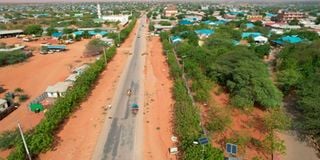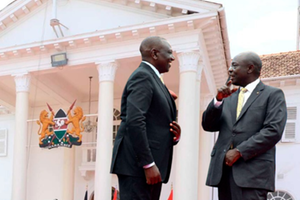Mandera Green Revolution epitomises the power of women in climate action

An aerial view of Mandera town where trees have been planted along the road, at government institutions and homesteads as a climate change mitigation strategy.
What you need to know:
- In July 2016, then Governor Ali Roba initiated an apparently over-ambitious greening programme.
- The programme mobilised some 1,200 women, primarily widows and the elderly from vulnerable families, and deployed them to plant and nurture trees.
The Mandera Green Revolution was on September 24 declared the winner of the “Living Green for Climate Change” category of the 2024 “Future Green City World Congress”, triumphing over major world cities. While this was a remarkable achievement for the county and Kenya as a whole, it is particularly one for women and one that demonstrates the concept and potential of women’s empowerment in practice.
Mandera is one of the arid counties of Kenya, ordinarily characterised by scorching sunshine, water scarcity and a dusty environment. But in July 2016, then Governor Ali Roba initiated an apparently over-ambitious greening programme. Eight years down the line, the fruits are there to be seen – a green cosmos contributing to climate change mitigation and environmental management.
As explained by the current governor, Mohamed Adan Khalif, the county assembly speaker when the programme was started, two additional ideas behind the programme were reformation of the unflattering public perception of the county as wasteland and creation of employment and income for women.
The programme mobilised some 1,200 women, primarily widows and the elderly from vulnerable families, and deployed them to plant and nurture the trees, initially of indigenous species but now a mixture with other varieties.
The women established nurseries and applied local techniques to protect the young trees for seven continuous years, with each caring for 20 trees and earning Sh10,000 monthly.
Inbuilt in this initiative are various elements of women’s empowerment. One is the economic dimension of income, hence improved financial independence. Two is the regularity of employment, hence continuous physical and mental activity that is good for personal health and social networking.
Three is the acquisition of new knowledge, skills and attitudes about the environment, thanks to the workshops conducted on the same by the county government.
Four is the dedication to a worthy cause not just for personal and immediate benefit but for the betterment of a whole county now and in the future. This is consonant with the 1987 Brundtland Report’s definition of sustainable development as “meeting the needs of the present generation without compromising the needs of the future (ones)”.
Simply put, the trees will provide several benefits over a long period of time. These include atmospheric purification, a cooler and more hospitable environment for residents and visitors, improved landscape aesthetics, increased biodiversity of plants and fauna that depend on trees (such as birds and insects), reduced soil erosion, and material benefits, such as fuelwood, timber for furniture and construction and herbal extracts for medicinal use.
Five is the development of self-esteem and recognition not only from the personal benefits but also from the global award. Six is the multiplier effect, that schools have been roped into the programme to increase coverage through replication, and the involvement of the family unit in the initiative, translating into increased environmental consciousness and a culture of valuing trees as a long term ecological and economic investment. Once such values are instilled, sustenance is more or less guaranteed.
Seven is that improved livelihoods would alleviate poverty and discourage youth from radical activities associated with idleness and poverty, hence eventually improving security. Eight is that Mandera becomes more attractive to people from other parts of the country and indeed elsewhere because of its liveability. This would translate into investment and tourism, which will obviously catalyse economic development.
The award itself puts the county on the global map, which is good for our national reputation and could translate into more funding to sustain the initiative, reported to be costing about Sh200 million annually in water supplies, generation of seedlings, wages and coordination.
The liveability certainly contributes to reduced outmigration of local people to other parts of the country, hence retention of their talents in the local economy, buoyed by enhanced patriotism, ownership, community-wide enlightenment and appreciation of the value of a green environment.
This is a classic illustration of community-based development and women’s empowerment. It should be a model for others to emulate and replicate. It justifies the need to grant women greater space and control over resources, planning and decision making.
In this case, the programme has only instrumentalised women. Imagine what would happen if they had control over land and other factors of production and could make decisions over them with the kind of knowledge and skills imparted by the programme.
The case illustrates the concept of empowerment as a process and an outcome. It is also an excellent case study that development practitioners should use in simplifying often abstract planning concepts such as theory of change and results chain.
Kenya could do with more of such initiatives instead of endless politicking and corruption.
The writer is a lecturer in Gender and Development Studies at South Eastern Kenya University ([email protected]).





